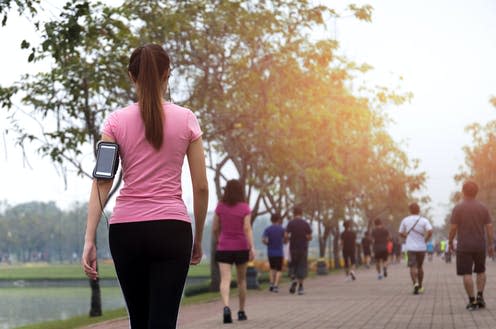Access to urban parks is far from equal – fining people who travel to reach nature is not the answer

Two women were recently issued with a £200 fine by Derbyshire police for driving five miles to a local reservoir for a walk. While the fine has since been rescinded, the case has prompted questions over why people are travelling to access nature, perhaps taking COVID-19 with them, under the current lockdown.
Fields in Trust, a green space charity, has noted that 2.69 million people in the UK live further than a ten-minute walk from a park or green space. This distance is considered a threshold for how far people will travel by foot.
Having to walk for more than ten minutes will discourage people from using a park, as will a park size of less than two hectares – considered an appropriate size needed to accommodate a community of 1,000 people.
What’s more, this doesn’t take into account the amenities such as playgrounds or toilet blocks – or the lack of them – available in a park, or its specific location. If reaching it requires crossing a busy road, people may be put off. With all this in mind, it’s likely that a lot of people have simply stayed at home during lockdown, sacrificing their mental health by not making use of parks.
Disparity in park use
There is a clear variation in provision and quality of parks across the UK. For example, London has over 3,000 green spaces, but their size and quality varies dramatically by borough. There also may be discrepancies in how much attention is paid to certain parks. In Liverpool there is a view that more resources go to parks such as Stanley Park and Sefton Park, leaving others neglected.
Cities such as Sheffield and Liverpool have struggled to find an appropriate balance in park funding. As such there should perhaps be a level of sympathy for people who might choose to travel to areas such as the Peak District or the Sefton coast, if their local parks are underfunded and lacking in amenities.
A particularly significant issue is the lack of access to parks in areas of high ethnic diversity when compared to areas made up of predominately white middle-class communities. In many parts of London, and in parts of Manchester large and diverse populations – such as those in New Islington, Ardwick, and the city centre in Manchester – are served by poor quality parks of inadequate size.
This reflects the historical development of estates and flats without the provision of corresponding public space. As a consequence, we see fewer members of these communities using green spaces because they are not as accessible.

This inequality is reflected in research by Natural England on access to and use of natural spaces during the pandemic. An estimated 71% of children from ethnic minority families in England spent less time outside (or in a green space) during the pandemic than they had previously, compared to 57% of children from white backgrounds. Children from poorer families – with an annual income of £17,000 or less – also spent less time outside than other children.
This disparity only increases when we review access to a private garden. In the UK, 12% of people do not have access to a garden. This rises to 21% in London, while black people are almost four times less likely to have access to a garden than white people.
This uneven access to green spaces means we should ask whether fining people who may be on a low income for travelling to spend time in nature is morally appropriate, especially where local parks may be unattractive to users.
How local government, and indeed national government, address this issue is complex. Recent government proposals argued for more beautiful and easier development of new homes. This does not address the need for more and better quality parks.
The alternative is to fund local authorities to invest in more parks, in more locations, for more people. By doing so, government would be providing the resource base within a ten-minute walk that people want, and providing more green space for people living in high density areas. This will, in the long run, improve local quality of life.
This article is republished from The Conversation under a Creative Commons license. Read the original article.

Ian Mell does not work for, consult, own shares in or receive funding from any company or organisation that would benefit from this article, and has disclosed no relevant affiliations beyond their academic appointment.

